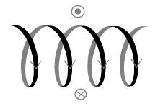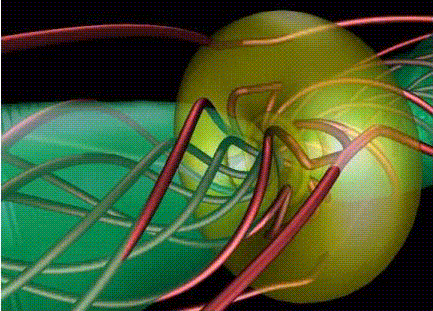Introduction
Active Galactic Nuclei (AGN) are energetic central regions of galaxies that are fueled by gravitational accretion of matter onto a supermassive black hole. Some of the energy contained in the matter that is outside the gravitational pull of the black hole is ejected in the form of jets.
Multi-wavelength VLBI polarization observations are used to study the magnetic-field structures of AGN, based on Faraday Rotation Measure (RM) gradients. Transverse RM gradients across the jets of AGN are interpreted as corresponding to helical magnetic fields wrapped around their jets; the gradients reflect the systematic change in the line-of-sight component of a toroidal or helical magnetic field across the jet, as suggested by Roger Blandford in the early 1990's, and also Denise Gabuzda. In fact, helical magnetic fields are predicted to come about in a natural way as a result of the "winding up" of an initial "seed" field by the rotation of the central accreting object (e.g. Nakamura, Uchida & Hirose 2001, Lovelace et al. 2002).


The picture on the right (adapted from www.astro.uva.nl/cp/) is an artist's perception of an AGN with helical magnetic field lines, the illustration on the left shows how a helical magnetic field can be explained by observing a transverse RM gradient. The cross shows the magnetic field component away from the observer, and the circle shows the magnetic field component pointed directly at the observer. The changing line-of-sight magnetic field component explains the transverse RM gradient that is observed.
Current Research at JIVE
Several sources have shown these Faraday Rotation Measure gradients in their parsec-scale jets. New features in their rotation measure distributions have also been discovered: a reversal in the direction of these gradients that happens either with distance from the core or over time. These dynamic gradients are best explained with 'magnetic-tower' type models (see illustration below). The net observed RM gradient will essentially be the sum effect of two regions of helical field, one nested inside the other. The direction of the net RM gradient will be determined by whether the inner or outer helix dominates the RM integrated through the jet, and RM gradient reversals will be observed if the inner and outer helical fields dominate in different regions of the jet.
Left: Rotation measure map of 0716+714 (at frequencies between 4.6-15.4 GHz) with total Intensity contours superimposed on top. The color scale on top shows the range of RM values in the map (units of rad/m^2). Here we observe two opposing gradients in the core and jet regions. This feature is best explained by magnetic tower models as described below.
 Right: Illustration showing how the magnetic field lines from a magnetic tower model (with the magnetic field lines going in the direction of outflow, finally looping back down to the accretion disk) can get wound up as an "inner" and "outer" helix (representing the opposing gradients in the RM maps as shown in the image above), as a result of the differential disk rotation. The first figure shows the direction of the magnetic field lines in this model, whereas the second follows the path of one of these magnetic field lines that gets wound up in a "nested helical field".
Right: Illustration showing how the magnetic field lines from a magnetic tower model (with the magnetic field lines going in the direction of outflow, finally looping back down to the accretion disk) can get wound up as an "inner" and "outer" helix (representing the opposing gradients in the RM maps as shown in the image above), as a result of the differential disk rotation. The first figure shows the direction of the magnetic field lines in this model, whereas the second follows the path of one of these magnetic field lines that gets wound up in a "nested helical field".
Contact
Questions about research at JIVE on Helical Magnetic Fields should be directed to Mehreen Mahmud.

